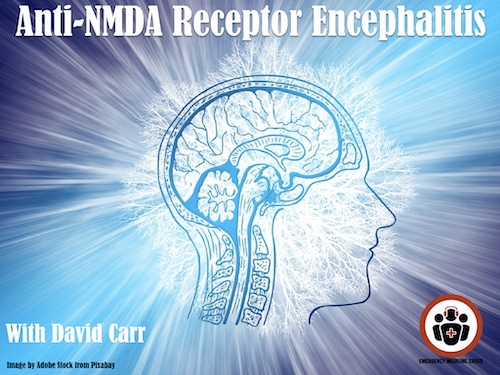Dr. David Carr presents his second of Carr’s Cases. This series features some potentially life-threatening diagnoses that may be perceived as zebras, but actually have a higher incidence then we might think – and if diagnosed early, can significantly effect patient outcomes. This Best Case Ever is about Anti-NMDA Receptor Encephalitis, a diagnosis that was only discovered in 2005, and has only recently been recognized by the Emergency Medicine community. Anti-NMDA Receptor Encephalitis may mimic a first presentation of schizophrenia or Neuraleptic Malignant Syndrome. It may present with seizure, altered mental status, autonomic instability or movement disorder in the absence of drug exposure. When you are faced with any of these presentations and no other diagnosis seems to fit, do an LP and send the CSF for anti-NMDA receptor antibodies. The time-sensitive treatment is IVIG and steroids. Anti-NMDA receptor Encephalitis is a must know diagnosis for all emergency medicine practitioners. Learn how to pick up this important diagnosis by listening to Dr. Carr’s Best Case Ever and following the links to further resources.
Published Aug, 2014 by Anton Helman
Dr. Carr’s prepublication article in CJEM on Anti-NMDA Receptor Encephalitis Full Text
Suzanna Callahan describes her experience of Anti-NMDA Receptor Encephalitis in her book, Brain on Fire
Concise review by Chris Nickson with more references on Life in the Fast Lane
Take Home Points
- predominantly a disease of young women (mean age = 21) with 7% mortality rate
- associated with pelvic teratoma tumors
- Four clinical phases: 1. flu-like prodrome 2. psychotic phase 3. altered mental status and dyskenesia 4. autonomic instability and seizures
- can mimic first episode psychotic disorder, NMS and Seratonin Syndrome
- diagnosis by LP with CSF positive for anti-NMDA receptor antibodies
- time to initiation of therapy with IVIG and steroids is best predictor of outcome
Check out this video showing the characteristic movement and behaviour of a patient with Anti-NMDA Receptor Encephalitis.
Key Reference
Young PJ, et al. A case series of critically ill patients with anti- N-methyl-D-aspartate receptor encephalitis. Crit Care Resusc. 2013 Mar;15(1):8-14.
Dr. Helman and Dr. Carr of no conflicts of interest to declare.





Super, super discussion of a very important topic. The only thing I’d add is that sometimes these patients, during the psychotic phase, get treated with a neuroleptic agent. This makes it even more likely that the later phases will be taken for neuroleptic malignant syndrome. Take-home lesson: in a young person with apparent NMS, the history should be reviewed carefully and the possibility of anti-NMDA receptor encephalitis considered.
Great point Leon. Yet another reason why benzodiazepines are a safer bet for sedation of psychotic patients in the ED.
I would recommend to determine the NMDAR anti-bodies titers level in CSF and serum, not just determination if its positive or negative,
P.S. It can be positive in serum as well not just in CSF
These patients may also present with psychomotor agitation and get ketamine, which will further propogate NMDA antagonism. Something to ponder as ketamine gains traction for psychomotor agitation and DSI in the ED and ICU.